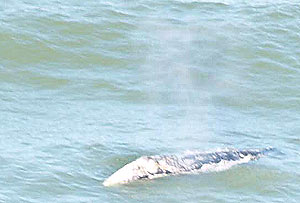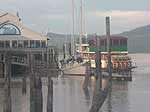 |
Published 08/01/09
Whales, Glowing Sand Put on a Show on Oregon Coast
 |
| Whale spouting near Seaside (photo Jaime Oxley, Seaside Aquarium) |
(Oregon Coast) – It's not simply been the place of respite and escape from the heat for humans, but interesting critters – both microscopic to massive – have been buzzing about the beaches lately.
Glowing sand has been seen on the Oregon coast this past week, and conditions are ripe to see more of these unique forms of phytoplankton at night. Gray whales have made a splash along the coast, including parts of the northern coast you don’t normally see them, along with other fun glimpses of nature.
Tiffany Boothe and Jaime Oxley of Seaside Aquarium not only spotted some gray whales in the north coast resort town but photographed them.
“We often get gray whales here in the cove this time of year, but they often stay longer when we are having a good anchovy run, which we are currently having,” said Boothe.
The whales were spotted in the cove area – at the southern end of Seaside. While they may be around frequently, they’re hard to spot because of large waves there.
“They are on their way up to their summer feeding grounds up in the Bering Sea, and just stop here for a snack,” Boothe said. “We have been getting a lot of reports from people seeing calves.”
 |
| A baby gray whale photographed by Oxley near Seaside. |
Those whales were photographed in mid-July. But Aquarium manager Keith Chandler said they are still being spotted.
“People are also seeing harbor porpoises, and a lot of birds. Pelicans can be seen diving for the small anchovies. We have even gotten reports that the anchovies are starting to run up into the rivers.”
A few years ago, there were perhaps millions of anchovies that flooded the local rivers on the north coast. There were so many that there was not enough oxygen in the water and many perished - washing up along the banks, creating an unpleasant fishy smell.
Whales were putting on a show on the central coast in late July as well. Around the Otter Crest Loop Road area, a pair of them loitered for a few days on and off, sometimes meandering in a small, cove-like area next to a wayside just south of Whale Cove. They were seen churning and blowing in the water, as they maneuvered in and out of the tiny space. Crowds were gathered above, as were some whale watch boats just offshore. After their little spinning show in the water, they would move south or north, periodically appearing above water to spout.
 |
| Whales were seen in late July around this spot just south of Depoe Bay. |
Good viewing conditions, of course, make all the difference. The Whale Watch Center in Depoe Bay reported eight whale sightings in the first two days of August. They reported a somewhat record of 200 sightings in July – as opposed to the 109 in July of ’08 and 87 in July of ‘07.
Glowing sand made its appearance this week as well. BeachConnection.net staff spotted it in the nocturnal beaches of Rockaway Beach, albeit rather faint.
One large, bright flash was seen at the tideline at around 4 a.m. It looked like someone lighting up a cigarette in the distance or clicking on a flashlight very briefly. This is rare and quite spectacular. The rest of the time, it manifested itself in the form of the usual tiny, faint flickers or sparks seen on the wet sand when you disturb them with your feet.
 The creatures are a form of phytoplankton called dinoflagellates – part of the family of microscopic plants that form the bottom of the food chain for marine life. This particular brand is bioluminescent, meaning they give off a glow when disturbed or bumped through internal chemistry processes, much in the same way a firefly does.
The creatures are a form of phytoplankton called dinoflagellates – part of the family of microscopic plants that form the bottom of the food chain for marine life. This particular brand is bioluminescent, meaning they give off a glow when disturbed or bumped through internal chemistry processes, much in the same way a firefly does.
 |
| Glowing phytoplankton as photographed by Boothe in 2007: the two bluish dots are the only ones visible. |
They tend to hit Oregon’s beaches in warmer periods when nutrients can be more abundant and more sunlight can help “charge them up.”
The luminescence of a single dinoflagellate lasts for 0.1 seconds, which is why photographing the phenomenon is next to impossible. Larger organisms, such as jellyfish, can be luminescent for tens of seconds.
In Rockaway Beach, the locals sometimes call it “star stompin’,” because it can look like small stars erupting beneath your feet.
To see it yourself, you may find it on any dark beach in Oregon at this time – although it depends on random conditions that cannot be predicted. If they are to be found, look for wet sand near the tide line. Sometimes wet sand or pools that have been around for a while – and quite a ways from the tide line – may produce the wee glowing beasties.
Look for a beach with no ambient light interference from the streets or houses.
For more about Oregon Coast lodging....
 |
 |
 |
RELATED STORIES
Unusual Travel Articles TravelParanormal.com allows you to submit your own creepy tale or debunk one - or see up-to-the-minute news headlines about travel and the paranormal.
Watching Transformations of Oregon Coast Beaches Seasons change and so do beaches, revealing different sides and a variety of eye-popping sights
Staggeringly Cool Ideas for Oregon Coast Romance Be it the season of Valentine's or be it any time of the year, Oregon's coastline has essentially cornered the market for cuddle-inducing possibilities and gushy activities for the hand-holding set
Day or Night Mysteries and Merriment on Oregon Coast It's more than just nightlife that comes to life, but the beaches offer major opportunities
News Headlines from All Over Oregon Need to scan Oregon headlines? Constantly updated news from all over Oregon: a comprehensive, up-to-the-minute display of news headlines from a variety of media.
Secrets of the Season |




































